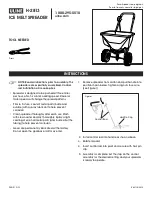
•
We recommend that you clean the equipment immediately after you use it.
•
Wipe housing with a clean cloth and blow it down with compressed air
at low pressure. Remove all
foreign material from the
product. Pay particular attention
to battery seating and spreading
wheel is clear of any residue.
•
Ensure that no water can
get into the interior of the
equipment.
•
Store it in a cool, dry, and well-
ventilated place that is inaccessible to children.
•
For transportation in a vehicle, secure the product against movement or
falling to prevent injury to persons or damage to the product.
TROUBLESHOOTING
Spare parts can be ordered from the Special Orders Desk at
your local Bunnings Warehouse.
For further information, or any parts not listed here, visit
www.ozito.com.au or contact Ozito Customer Service:
Australia 1800 069 486
New Zealand 0508 069 486
E-mail: [email protected]
SPARE PARTS
The tool is equipped with the battery protection system, which helps to ensure a long service life.
The output power automatically cuts off during operation when the tool and/or battery are placed
under the following situations:
WARNING!
ALWAYS ENSURE THE TOOL IS SWITCHED
OFF AND THE BATTERY IS REMOVED PRIOR TO ANY
MAINTENANCE.
Problem Cause
Remedy
Sprayer is not
starting
Battery is low in charge.
Charge battery
Battery not inserted
properly.
Insert battery pack correctly.
Spreader is
not operating
at full
capacity
Material blocked.
Empty hopper and set to a low speed, run
for a few seconds to remove any residue
material. Resume normal operation.
Motor stops
while in
operation
Battery has no power.
Charge battery.
Note: Ozito Industries will not be responsible for any damage or injuries caused by the repair of
the garden sprayer by an unauthorised person or by mishandling of the garden sprayer. This tool is
designed for DIY use - use in commercial or industrial environments will void the warranty.
Read instruction manual
Do not use in the rain or leave garden spreader outdoors while raining.
Wear eye protection.
Regulator compliance mark
Wear a breathing mask
Keep bystanders away. Do not operate whilst people
especially children or pets are in the area.
Wear non-slip, heavy duty gloves
DESCRIPTION OF SYMBOLS
THIS MANUAL CONTAINS IMPORTANT SAFETY AND OPERATING INSTRUCTIONS FOR YOUR
BATTERY CHARGER.
1.
Before using the charger read all instructions and cautionary markings on the charger, battery pack and the product
using the battery pack.
2.
This charger is not intended for any uses other than charging rechargeable batteries. Any other use may result in risk
of fire, electric shock or electrocution.
3.
Do not place any object on top of the charger or place the charger on a soft surface that may result in excessive
internal heat. Place the charger in a position away from any heat source.
4.
To reduce risk of damage to the electric plug and cord, pull by the plug rather than the cord when disconnecting the
charger.
5.
Make sure the cord is located so that it will not be stepped on, tripped over, or otherwise subjected to damage or
stress.
6.
An extension cord should not be used unless absolutely necessary. Use of an improper extension cord could result in the risk
of fire, electric shock or electrocution.
7.
Do not operate the charger if it has received a sharp blow, been dropped or otherwise damaged in any way. Have it
checked by an electrician or power tool repairer.
8.
Do not disassemble charger. Take it to an electrician or power tool repairer when service or repair is required. Incorrect
reassembly may result in a risk of electric shock, electrocution or fire.
9.
To reduce risk of electric shock, unplug the charger from the outlet before attempting any cleaning. Removing the
battery pack will not reduce this risk.
10.
Never attempt to connect 2 chargers together.
11.
DO NOT store or use the tool and battery pack in locations where the temperature may reach or exceed 40ºC (such as inside
sheds or metal buildings in summer).
12.
The charger is designed to operate on standard household electrical power (240 volts). Do not attempt to use it on any
other voltage!
13.
The battery pack is not fully charged out of the carton. First read the safety instructions and then follow the charging
notes and procedures.
14.
The longest life and best performance can be obtained if the battery pack is charged when the air temperature is
between 18 - 24ºC. Do not charge the battery pack in an air temperature below 10ºC or above 40ºC. This is important
and will prevent damage to the battery pack.
15.
Do not incinerate the battery pack even if it is seriously damaged or is completely worn out. The battery can explode in
a fire.
16.
Never attempt to open the battery pack for any reason. If the plastic housing of the battery pack breaks or cracks, immedi-
ately discontinue use and do not recharge.
17.
During charging, the battery must be placed in a well ventilated area.
BATTERY AND CHARGER SAFETY WARNINGS
MAINTENANCE
Battery protection system
• When the tool is overloaded:
If this occurs, release the trigger switch and remove causes of overload, then pull the switch
trigger again to restart.
• When the remaining battery capacity becomes low:
Recharge the battery pack.
Note:
The battery protection system does not in any way damage the tool.
Note:
The indicated capacity may be lower than the actual level during use or immediately after
using the tool.
12
34 56
7
8
























